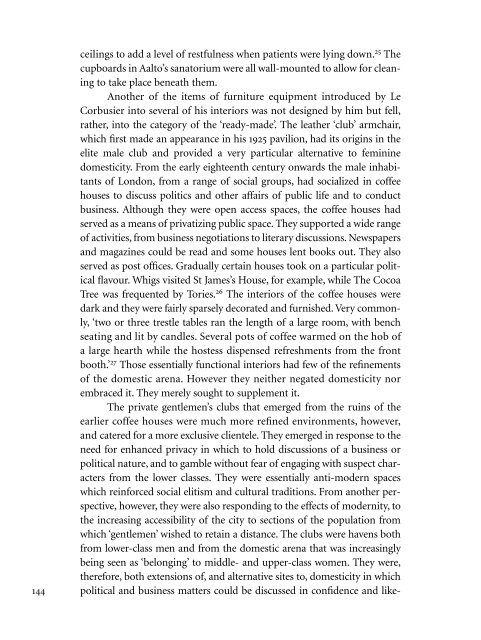Create successful ePaper yourself
Turn your PDF publications into a flip-book with our unique Google optimized e-Paper software.
144<br />
ceilings to add a level of restfulness when patients were lying down. 25 <strong>The</strong><br />
cupboards in Aalto’s sanatorium were all wall-mounted to allow for cleaning<br />
to take place beneath them.<br />
Another of the items of furniture equipment introduced by Le<br />
Corbusier into several of his interiors was not designed by him but fell,<br />
rather, into the category of the ‘ready-made’. <strong>The</strong> leather ‘club’ armchair,<br />
which first made an appearance in his 1925 pavilion, had its origins in the<br />
elite male club and provided a very particular alternative to feminine<br />
domesticity. From the early eighteenth century onwards the male inhabitants<br />
of London, from a range of social groups, had socialized in coffee<br />
houses to discuss politics and other affairs of public life and to conduct<br />
business. Although they were open access spaces, the coffee houses had<br />
served as a means of privatizing public space. <strong>The</strong>y supported a wide range<br />
of activities, from business negotiations to literary discussions. Newspapers<br />
and magazines could be read and some houses lent books out. <strong>The</strong>y also<br />
served as post offices. Gradually certain houses took on a particular political<br />
flavour. Whigs visited St James’s House, for example, while <strong>The</strong> Cocoa<br />
Tree was frequented by Tories. 26 <strong>The</strong> interiors of the coffee houses were<br />
dark and they were fairly sparsely decorated and furnished. Very commonly,<br />
‘two or three trestle tables ran the length of a large room, with bench<br />
seating and lit by candles. Several pots of coffee warmed on the hob of<br />
a large hearth while the hostess dispensed refreshments from the front<br />
booth.’ 27 Those essentially functional interiors had few of the refinements<br />
of the domestic arena. However they neither negated domesticity nor<br />
embraced it. <strong>The</strong>y merely sought to supplement it.<br />
<strong>The</strong> private gentlemen’s clubs that emerged from the ruins of the<br />
earlier coffee houses were much more refined environments, however,<br />
and catered for a more exclusive clientele. <strong>The</strong>y emerged in response to the<br />
need for enhanced privacy in which to hold discussions of a business or<br />
political nature, and to gamble without fear of engaging with suspect characters<br />
from the lower classes. <strong>The</strong>y were essentially anti-modern spaces<br />
which reinforced social elitism and cultural traditions. From another perspective,<br />
however, they were also responding to the effects of modernity, to<br />
the increasing accessibility of the city to sections of the population from<br />
which ‘gentlemen’ wished to retain a distance. <strong>The</strong> clubs were havens both<br />
from lower-class men and from the domestic arena that was increasingly<br />
being seen as ‘belonging’ to middle- and upper-class women. <strong>The</strong>y were,<br />
therefore, both extensions of, and alternative sites to, domesticity in which<br />
political and business matters could be discussed in confidence and like-



